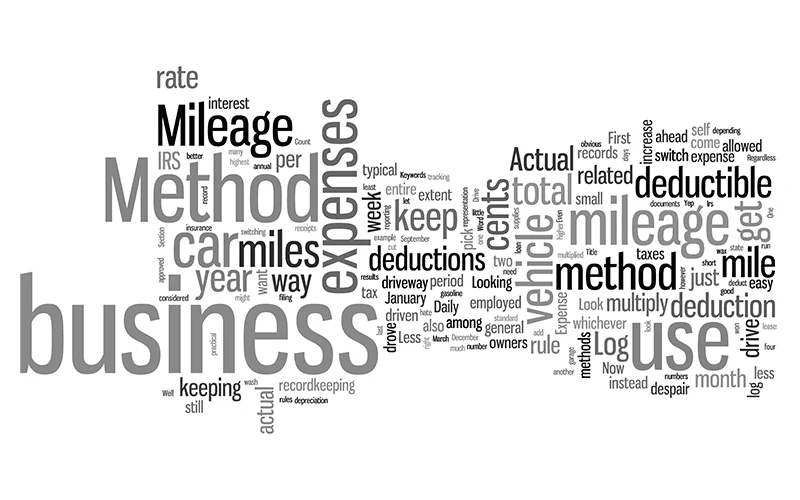Bianca started her massage therapy business three years ago after getting her license. She began by offering in-home services to the local area. However, as more referrals poured in, her business gradually grew to encompass larger geographic areas.
She decided to pass the travel costs to her clients, but she recently realized she is now paying income tax on her travel costs because she didn’t deduct her travel expenses. (Income is taxed, so if you charge clients for travel expenses instead of deducting those travel expenses, you are in effect paying income tax on your travel expenses.)
Like many business owners, Bianca didn’t know how to properly track and deduct her automobile on her tax return.
The IRS gives business owners two options for accounting and deducting vehicle-related expenses. You must know which method will be most beneficial and how to accurately track the deductions. The following cover three steps for effective mileage deduction for business owners, plus two common pitfalls and a bonus tax strategy.
1. Track mileage and expenses
The first step in deducting the business use of your vehicle is to set up a system of record keeping to track how many of your vehicle miles are for business. There are many great tracking apps for both Android and Apple, and it’s likely your bookkeeping software already has a similar feature.
2. Choose a method
There are two IRS-approved methods to calculate your vehicle deduction amount. The first is the actual expense method, where you use the actual expenses incurred to calculate your deduction. This method involves more tracking and accounting than the second method, as you must track all vehicle-related expenses, including gas, repairs, insurance, etc.
The second is the standard mileage method, where the IRS permits you to use a standard rate per mile to calculate your vehicle deduction amount. This rate changes year to year, and in some years (like 2022) it can change midyear. The calculation is simple: Multiply the number of miles by the standard rate.
3. Finalize your deduction
Year to year, it’s easy to decide between the two methods, but adopting a consistent long-term approach can be harder, as this requires forecasting.
Here’s a tip to help you decide: Think of the vehicle as falling on a scale. On one side, you have an affordable vehicle that will be used for many miles, such as a traveling massage therapist using a budget sedan. On the other side, you have a sparsely used luxury vehicle, such as an executive using a luxury car for infrequent business lunches.
If you forecast that the vehicle will rack up many business miles, the standard mileage rate will likely be better. Conversely, if you sparingly drive a luxury vehicle for business, the actual cost method may be of greater benefit. Consult with your accountant to determine the best method for unique situations and to discuss documentation requirements.
4. Watch out for depreciation recapture
Most assets, especially automobiles, depreciate over time. When the amount of depreciation you deducted on your taxes exceeds the amount of actual depreciation, the IRS requires that you treat this excess as income. The standard mileage rate includes depreciation, and it’s possible that you might have depreciation recapture if you use it.
This, however, is highly unlikely, as the IRS depreciation rate included in the standard mileage rate is conservative and rarely results in depreciation recapture.
5. Don’t forget the mileage log
Both mileage calculation methods require that you keep a log to track the vehicle mileage used for business. It’s important that the log is kept day-to-day and not reconstructed, or you might find your deduction disallowed in an audit. Additionally, remember that commuting is personal use, not business use.
Bonus tax strategy: Buy a fancy car and write it off
If you want to buy a luxury vehicle for yourself, and more importantly, take a deduction for it, it can potentially save you up to 50% of the value, depending on your state. (This calculation adds the maximum IRS tax rate of 37% plus state tax rates; in California, as an example, the maximum is 13.3%, which adds up to about 50%.)
While this is possible, there are strict rules you must follow. First, you must designate and use the vehicle for your business only. Second, you will need to use the actual cost method, so watch out for depreciation recapture if you don’t plan to keep the car for an extended term.
Any costs you incur for your business should be written off when filing your taxes, and business mileage on a personal car is no exception. Keep a record of your spending and usage, then decide on a legal tax deduction strategy. And be sure to adhere to the paperwork requirements to prevent losing deductions in the future.
Bianca’s lesson learned
After some online research, Bianca discovered she had been omitting a significant tax deduction for her company. Since her business was growing too large for her to manage on her own, it was now time to employ professional help.
While meeting with her accountant, Bianca’s priority is to set up a system to monitor and deduct business mileage.
Contact Kleshinski, Morris & Morrison CPAs
If you need help formulating your tax saving strategies, contact the experts at Kleshinski, Morrison & Morris CPAs. Call our office at 419-756-3211, reach us by sending email to kmm@kmmcpas.com, or just fill out the contact form on our website at this link.

